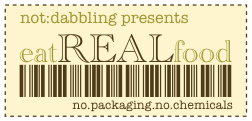
At Earth Hour dinner the other night, my hostess Holly sent us all home with slices of chocolate chip date cake. I didn't realize how deeply I had internalized the idea of avoiding one-use plastic until I felt myself cringe as she casually pulled out a ziplock bag to wrap it in. I didn't say anything, but that ziplock bag is sitting on my counter still, several days later, like Banquo's ghost.
Holly is about as green as they come--active on the American Institute of Architect green design committees, spearheads construction debris reuse for a department of the city of Chicago, an avid cook. But she didn't think twice about pulling out that ziplock bag.
We pack a lot of things in throwaway wrappers that we ought to be reusing. How many times have you gone to the grocery store and left your 14 canvas bags in the car? And you get to the check out, and just say, oh they're in the car I'll just use plastic today. But why not go back out to the car and get the bags? Or put the groceries back into the cart and bag them when you get to the car. I shake my head in wonder every time I see some young mother, of a generation who should know better, and in affluent areas of the city where one assumes a degree of awareness and buy-in, leaving the grocery store with groceries stuffed into 20 or 30 petroleum-based plastic bags. What will it take to create awareness and a willingness to act when mothers like that don't even understand that what they're doing is wrong.
Doggie bags made of styrofoam. Lunchboxes made of plastic. When will we learn that avoiding these things is easy, cheap and necessary. We simply cannot keep casually wrapping in plastic a piece of cake that's going to be consumed 10 minutes later.
We need to teach our children to be thoughtful and planning-oriented. We need to train ourselves to stewardship; to bring the bags in from the car, or go back out for them if we forget. We need to pack our fruit in paper bags, and never buy another ziplock again. Or at the very least, to wash them.
Green isn't just reading the proper blogs and donating to Jamie Oliver's Food Revolution. Green is getting to the point where you cannot bring yourself to use plastic when there's an alternative, and to have the courage to tell your friend, "just wrap it in wax paper."
Another risotto
1 cup Arborio rice
4 tablespoons butter
1/4 cup raisins (they can be crusty old dry ones, which is what actually inspired this)
1 medium onion, diced
1 eggplant, roasted (or from frozen preserved)
2-3 cups broth
salt and pepper to taste
grated hard cheese
Remember, you cannot leave risotto for even a minute--keep stirring or you'll be scrubbing a burnt pot later.
Heat the broth to a simmer, and keep it there. Melt the butter in a large saucepan. Add the raisins and saute about a minute, add the onions and saute until they just start to go transparent. Add the rice and saute about 5 minutes, until they start to look a little toasted (not burnt).
Start adding the simmering broth 1/2 cup at a time. It's important to add the broth in small amount and allow it to absorb into the rice completely before you add more. When the first 1/2 cup is absorbed, add another, and allow it to be absorbed. When you've used half the broth, add the eggplant, stirring thoroughly. The eggplant adds a lot of moisture, so allow that moisture to be absorbed as well.
Continue to add the simmering broth 1/2 cup at a time, until the dish is sticky but not glutinous. I've never used all the broth, the one I made last night used only 2 cups because of all the moisture in the eggplant.
Serve hot, sprinkle with grated cheese. This dish does not keep well.













